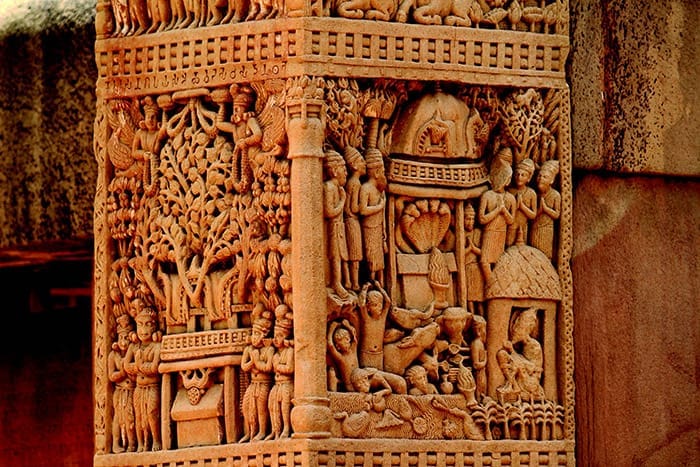
Mauryan Empire
The history of the Mauryan Empire during approximately 324 to 187 BCE is illuminated by various literary sources, providing valuable insights into this period. Several texts shed light on different aspects of the Mauryan Empire, including:
- Banabhatta’s Kadambari.
- Buddhist texts like Mahavamsa, Milindapanho, and Mahabhashya, which offer accounts of Chandragupta’s life.
- Buddhist texts such as Dipavamsa, Ashokavadana, Divyavadana, and Mahavamsa, which provide insights into Ashoka’s life.
- Hema Chandra’s Parishishta Parvan, which establishes Chandragupta’s connection with Jainism.
- Vishakhadatta’s Mudrarakshasa, a historical drama from the 5th century CE, describing the clever strategies of Chanakya against Chandragupta’s enemies.
These texts collectively offer detailed information about the life and governance of the Mauryas, with a special focus on the significance of Arthashastra and Indica among them.
Arthashastra
- Kautilya’s Arthashastra is a Sanskrit text that can be understood as “the science of material well-being” or “the science of statecraft.”
- In the Arthashastra, material well-being (artha) is considered more important than spiritual well-being (dharma) and sensual pleasure (kama).
- This text, composed of 15 books (Adhikaranas), presents the political philosophies of Kautilya, the chief minister of Chandragupta Maurya, who is also known as Chanakya or Vishnugupta.
- Kautilya is often compared to Nicolo Machiavelli, the Italian Renaissance author of ‘The Prince.’ His Arthashastra offers guidance for rulers aiming to govern effectively.
- The text covers various topics in detail, such as diplomacy, warfare, prisons, law, taxation, agriculture, mining, fortifications, administration, trade, and espionage.
- Kautilya also addresses controversial subjects, including assassinations, the management of secret agents, when it might be necessary to harm family members, when treaties can be violated, and when it’s essential to spy on ministers.
- He emphasizes the moral duty of a king, highlighting the importance of the happiness and welfare of the subjects as the true measure of a ruler’s success, stating that the subjects’ well-being is the king’s well-being, and their happiness is his duty.
Megasthenes Indica
- Megasthenes, a Greek ambassador sent by Seleucus Nikator, lived in the Maurya capital, Pataliputra, during the reign of Chandragupta Maurya.
- He wrote an account of Pataliputra’s administration and the Mauryan empire.
- While Megasthenes’ complete account is lost, fragments of his work are found in the writings of later Greek authors.
- These fragments have been compiled into a book that sheds light on the Mauryan empire’s administration, society, and economy.
- In his work, Indica, Megasthenes describes the subcontinent’s geographical features, including its size and shape (India is described as a quadrilateral country with the ocean to the south and east), soil, climate, rivers, flora, fauna, administration, society, legends, and folklore.
- One limitation of Megasthenes’ work was the classification of society into seven classes based on profession, which differed from the prevalent four-fold caste system of the time. However, he identified two key aspects of the Indian caste system – endogamy and hereditary occupations.
- Both Kautilya’s Arthashastra and Megasthenes’ Indica offer valuable insights into the Mauryan dynasty, one of the most powerful and influential dynasties of that era.
Mauryan Dynasty
- The Mauryan dynasty was established by Chandragupta Maurya (324/321-297 BCE), who conquered a vast territory in North India, the northwest, and a significant part of the Deccan region.
- While Buddhist texts mention the existence of a Kshatriya clan called Mauryas near Gorakhpur, close to Nepal, Brahmanical sources consider them to be Shudras.
- According to the Vishnu Purana, Chandragupta Maurya was the eldest son of Maurya, who was the son of Nanda king Sarvarthasiddhi, born to Mura, the daughter of a hunter.
Chandragupta Maurya (324/321 – 297 BCE)
- The Mauryan dynasty was founded by Chandragupta Maurya, with guidance from Chanakya/Kautilya.
- According to the Greek writer Justin, Chandragupta Maurya conquered all of India with an army of 600,000. He freed northwestern India from the rule of Seleucus, who governed the area west of the Indus River.
- In their war, Chandragupta emerged victorious. Eventually, peace was established, and Seleucus granted him eastern Afghanistan, Baluchistan, and the region west of the Indus in exchange for 500 elephants.
- Chandragupta Maurya was the main architect of the Mauryan empire. He initially established his rule in Punjab and then expanded eastward to control the Magadha region.
- Chandragupta’s empire covered Bihar, significant parts of Orissa and Bengal, western and northwestern India, and the Deccan. The Mauryans ruled over almost the entire subcontinent, except for Kerala, Tamil Nadu, and parts of northeastern India.
- According to Jain texts, Chandragupta Maurya adopted Jainism and eventually practiced Sallekhana, a form of voluntary death by slow starvation in the hills of Shravanabelagola near Mysore.
Bindusara (297 – 273 BCE)
- Bindusara was also known as Amitrochates (destroyer of foes) to Greek scholars, while the Mahabhasya referred to him as Amitraghata (killer of enemies). According to the Ajivika sect, a fortune-teller prophesied to Bindusara about his son Ashoka’s future greatness.
- Bindusara expanded his empire to include the land between the Arabian Sea and the Bay of Bengal. A 17th-century history of Buddhism written by the Tibetan monk Taranatha mentions that one of Bindusara’s officials, Chanakya, defeated the nobles and kings of 16 towns, making Bindusara the ruler of the territory between the eastern and western seas.
- According to Greek sources, Bindusara had diplomatic relations with western kings. Strabo reported that Antiochus, the Syrian king, sent Deimachus as an ambassador to Bindusara’s court.
- It is believed that Bindusara followed the Ajivika sect. During his reign, the Mauryan empire extended its rule over almost the entire subcontinent, reaching as far as Karnataka.
Maurya Empire- Chandragupta and Bindusara GK MCQs With Answer & Explanation in English








Leave a Reply